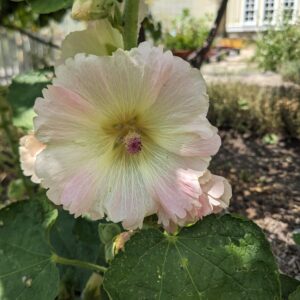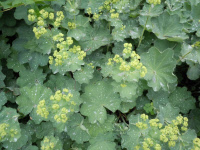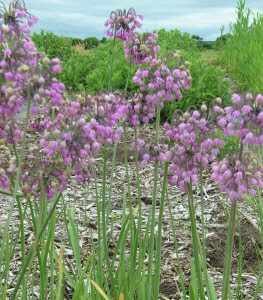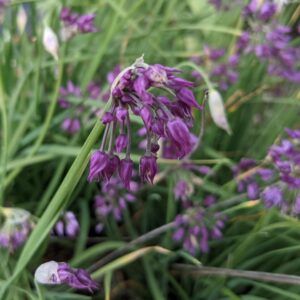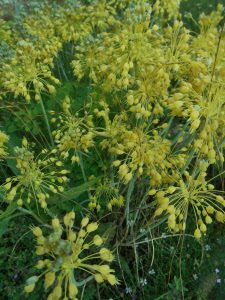Our Plants
Showing 17–24 of 587 results
-
Alcea rosea Hollyhock BIENNIAL Z 4-9
Early to late summer spikes of single platters - mixed colors. The classic cottage garden flower.
Early to late summer spikes of single platters – mixed colors. The classic cottage garden flower.
Size: 2-5' x 2'
Care: Sun in well-drained soil.
Native: West Asia
Wildlife Value: Butterfly plant, host for Painted Lady butterfliesHollyhocks have been cultivated in China for thousands of years where it symbolized the passing of time. They cooked the leaves for a vegetable and, also ate the buds. Transported from Middle East to Europe by the Crusaders and introduced to England by 1573. Grown in the Eichstätt Garden, the garden of Johann Konrad von Gemmingen, prince bishop of Eichstätt in Bavaria, c. 1600. Culpepper, a 17th century English herbalist, claimed the plant could be used to cure ailments of the “belly, Stone, Reins, Kidneys, Bladder, Coughs, Shortness of Breath, Wheesing, … the King’s Evil, Kernels, Chin-cough, Wounds, Bruises, Falls. . . (and) Sun-burning.” Both single and double forms grew in England by the time of Parkinson (1629). Parkinson said they came “in many and sundry colours.” John Winthrop Jr. introduced the 1st hollyhock to the New World in the 1630’s. Grown at America’s 1st botanic garden, Elgin Botanic Garden 1811.
In the 1880’s Mr. W. Charter of Saffron Walden in England cultivated frilly doubles, now known as ‘Charter’s Doubles.’
-
Alcea rosea var. nigra Black hollyhock BIENNIAL Z 4-9
Early to late summer spikes of single jet-black/maroon platters.
Early to late summer spikes of single jet-black/maroon platters.
Size: 5-7’ x 24”
Care: sun in well-drained soil
Native: West Asia
Wildlife Value: Attracts bees, butterflies and birdsHollyhocks have been cultivated in China for thousands of years where it symbolized the passing of time. They cooked the leaves for a vegetable and also ate the buds. Transported from Middle East to Europe by the Crusaders and introduced to England by 1573. Grown in the Eichstätt Garden, the garden of Johann Konrad von Gemmingen, prince bishop of Eichstätt in Bavaria, c. 1600. Culpepper, a 17th century English herbalist, claimed the plant could be used to cure ailments of the “belly, Stone, Reins, Kidneys, Bladder, Coughs, Shortness of Breath, Wheesing, … the King’s Evil, Kernels, Chin-cough, Wounds, Bruises, Falls. . . (and) Sun-burning.” Both single and double forms grew in England by the time of Parkinson (1629). Parkinson said they came “in many and sundry colours.” John Winthrop Jr. introduced the 1st hollyhock to the New World in the 1630’s.
Thomas Jefferson grew this black variety at Monticello.
-
Alchemilla alpina Alpine lady’s mantle Z 3-9
From a low mound of palmate (shaped like an open hand) silvery-margined leaves with silver undersides emerge short frothy sprays of chartreuse-yellow flowers in early summer. Will rebloom if cut back flowers after bloom.
From a low mound of palmate (shaped like an open hand) silvery-margined leaves with silver undersides emerge short frothy sprays of chartreuse-yellow flowers in early summer. Will rebloom if cut back flowers after bloom.
Size: 6-8” x 8-12”
Care: sun to part shade in moist to moist well-drained soil
Native: Europe and southern Greenland
Wildlife Value: Deer and rabbit resistantThe species originally described by English botanist and gardener to Queen Mary, Leonard Plukenet (1641-1706).
-
Alchemilla mollis Lady’s mantle Z 3-8
June to July, clusters of starry chartreuse flowers bloom above sage green, scalloped, tooth-edged foliage that holds dew drops like beads of mercury.
June to July, clusters of starry chartreuse flowers bloom above sage green, scalloped, tooth-edged foliage that holds dew drops like beads of mercury.
Size: 12" x 12"
Care: Sun to part shade in moist soil
Native: East Carpathians, Caucasus
Awards: Royal Horticultural Society Award of Merit.Alchemilla derived from Arabic for alchemist, medieval chemists who attempted to transmute ordinary substances into gold. They used the dew drops which beaded on leaves to add to gold making recipes. “Lady’s mantle” comes from a legend that the plant was used to adorn the Virgin Mary. Gerard, a 16th century English herbalist, identified medicinal uses: cure inflammation from wounds, clot blood, help bruises and flu, aid conception and discourage miscarriages. Reputedly the plant also returned women to the former beauty of youth.
-
Allium cernuum Nodding onion, Prairie onion Z 4-8
Umbels of arching stems with nodding bells of lilac shading to pink or occasionally white. May to June.
Umbels of arching stems with nodding bells of lilac shading to pink or occasionally white. May to June.
We are very sorry, but due to state agricultural restrictions, we are not permitted to ship Allium bulbs to Idaho, or to the following five counties in the State of Washington: Adams, Benton, Franklin, Grant and Klickitat.
Size: 12”-18”x 3-6”
Care: sun to part shade in moist well-drained soil
Native: Canada to Mexico
Wildlife Value: nectar source for Hairstreak butterfly, Attracts hummingbirds. Alliums resist critters including deer, rabbits, squirrels, mice, and moles and voles. They cannot stand the onion-like smell of Alliums protecting near-by plants too.Cernuum is Latin meaning “nodding.” Many groups of 1st Americans ate the bulbs raw, roasted or dried for winter storage or as flavoring for soups and gravies. Cherokee used this plant medicinally to cure colds, hives, colic, “gravel & dropsy,” liver ailments, sore throats, “phthisic,” and feet in “nervous fever.” Those in the Isleta Pueblo were not quite as creative as the Cherokee and used this only for sore throats and infections. Meriwether Lewis collected this in Montana and wrote, “I met with great quantities of a small onion about the size of a musquit ball … They were crisp, white and well-flavoured. I gathered about a half a bushel of them before the crew arrivd.” Chicago is believed to be named for the Algonquin word for this plant chigagou.
-
Allium cyathophorum var. farreri Z 5-8
Clusters of nodding deep purple tubes flowering atop scapes in late spring to early summer above shorter grassy leaves.
Clusters of nodding deep purple tubes flowering atop scapes in late spring to early summer above shorter grassy leaves.
We are very sorry, but due to state agricultural restrictions, we are not permitted to ship Allium bulbs to Idaho, or to the following five counties in the State of Washington: Adams, Benton, Franklin, Grant and Klickitat.
Size: 6-12” x 9-12"
Care: sun to part shade in moist to moist well-drained soil
Native: mountains of northwestern China.
Wildlife Value: Alliums resist critters including deer, rabbits, squirrels, mice, and moles and voles. They cannot stand the onion-like smell of Alliums protecting near-by plants too.1st described in 1930. This variety named to honor intrepid plant explorer, writer and artist Reginald Farrer (1880-1920).
-
Allium flavum var. minus Yellow flowered garlic
Umbels of shatter-shot yellow florets, like fireworks, bloom atop blue-green stems in July.
Umbels of shatter-shot yellow florets, like fireworks, bloom atop blue-green stems in July.
We are very sorry, but due to state agricultural restrictions, we are not permitted to ship Allium bulbs to Idaho, or to the following five counties in the State of Washington: Adams, Benton, Franklin, Grant and Klickitat.
Size: 10” x 3”
Care: sun in moist well-drained soil
Native: Northern Turkey
Wildlife Value: Resists critters including deer, rabbits, squirrels, mice, and moles and voles. They cannot stand the onion-like smell of Alliums protecting near-by plants too. Attracts bees & butterflies
Awards: species received Royal Horticultural Society Award of Garden MeritDescribed by Swiss botanist Pierre Edmond Boissier before 1885
-
Allium senescens Corkscrew allium, German garlic, Greater mountain garlic Z 4-9
Lavender balls, up to 30 of them, atop thin, bluish, strap-like, twisting foliage – mid-summer day’s dream.
Lavender balls, up to 30 of them, atop thin, bluish, strap-like, twisting foliage – mid-summer day’s dream.
We are very sorry, but due to state agricultural restrictions, we are not permitted to ship Allium bulbs to Idaho, or to the following five counties in the State of Washington: Adams, Benton, Franklin, Grant and Klickitat.
Size: 6-12” x 6-12”
Care: sun to part shade in well-drained to moist well-drained soil
Native: Siberia
Wildlife Value: Attracts butterflies & bees. Resists critters including deer, rabbits, squirrels, mice, and moles and voles. They cannot stand the onion-like smell of Alliums protecting near-by plants too.Cultivated before 1753. According to Philip Miller’s 1768 Dictionary, “planted in gardens for the variety of their flowers.” Grown at America’s 1st botanic garden, Elgin Botanic Garden 1811.

